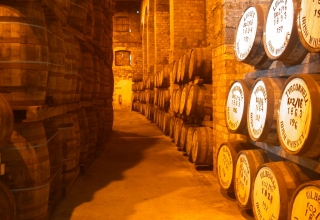
A guitar crafted in zebrawood
Few living organisms are as beneficial to humans during the course of their life, and thereafter, in their death, as the tree. After its demise it continues to provide wood for human construction, furniture and fuel, musical instruments and works of art, cricket bats, chopsticks and toothpicks. It seems natural to admire a beautiful wooden table or parquet flooring often above their manmade material counterparts. It is a substance familiar to humans and there is a story in all our homes tying wood to the course of our lives.

The Wonderwerk Cave in the Kalahari, South Africa. Evidence suggest early humans were around the fire 1.9 million years ago
In older homes, for example, in a massive cave at the edge of the Kalahari Desert in South Africa, scientists have uncovered an extensive record of human occupation including the evidence of plant ash and charred bone fragments. In this cavern, called the Wonderwerk Cave, humans were gathered round the fire 1.9 million years ago enjoying the benefits of warmth and more digestible food. These were humans even before our current species, most likely Homo erectus, and one must wonder at the stories within their smoky home.

Irish whisky maturing in oak barrels
We still enjoy the taste of wood smoke, whether it be smoked salmon or Lancashire cheese, the Sunday barbeque or the smoked tofu. And how would our whiskies and bourbons taste without Quercus robur (European oak), Quercus alba (American oak) and Quercus mongolica (Japanese oak)? And let us not forget the natural properties of wood. It is an insulator 15 times more effective than masonry and 400 times more than steel, thus explaining why wooden window frames are thermally efficient. Wood is a natural polymer – cellulose fibers in parallel strands are held by a lignin binder. These long strands of fibers resist stress and spread the load or force over their length, making a break across the grain difficult.

Logging in the Amazon
But these boons provided by wood have made the tree ever so popular, so popular that demand exceeds supply. Traditional logging where only large trees were removed and where natural regeneration was permitted, has changed to commercial logging where yields are examined per unit area, and vast swathes are cut removing many species. Even if replanted these areas are usually poor in life as they contain monocultures. So while an ever part of our lives which will continue for years to come, we should pay attention to the wood in our homes and where it comes from, making an effort to choose varieties from sustainably harvested forests.